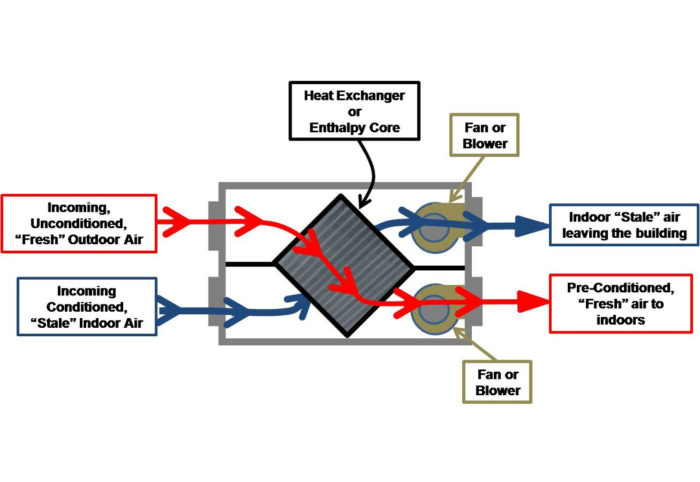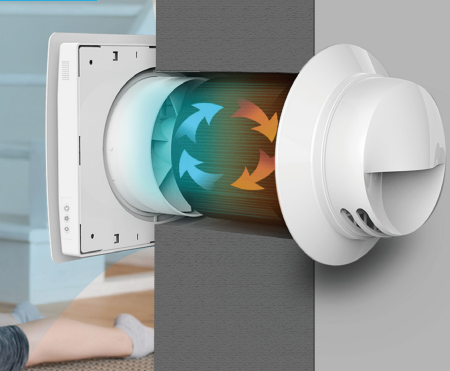How Does HRV and How It Works
Wiki Article
Discovering the Advantages of Heat Recovery Ventilation for Power Effectiveness in Residences
Heat Recovery Ventilation (HRV) systems provide homeowners a practical strategy to boosting power effectiveness. By reclaiming warm from outbound air, these systems can considerably reduce heating and air conditioning expenses. In addition, they give a consistent supply of fresh air, enhancing interior air quality and convenience degrees. As property owners take into consideration lasting alternatives, understanding the nuances of HRV systems becomes progressively crucial. What elements should one evaluate prior to making such an investment?Understanding Heat Recovery Ventilation Equipments

How HRV Improves Indoor Air High Quality

Power Cost Savings: The Monetary Advantages of HRV
Maximizing power effectiveness, heat recovery ventilation (HRV) systems provide significant monetary advantages for homeowners. By recuperating and reusing heat from exhaust air, HRVs substantially minimize heating & cooling prices. This innovation can result in power financial savings of up to 30%, relying on climate and usage patterns. Home owners commonly discover reduced utility More Help costs soon after installation, making HRVs a monetarily sensible investment over time. Furthermore, many regions supply rewards or refunds for energy-efficient upgrades, better boosting the monetary appeal. As power rates remain to climb, the cost-effectiveness of HRVs comes to be progressively clear. In general, the incorporation of HRV systems not just advertises power efficiency yet additionally adds to long-lasting economic cost savings for homes.The Environmental Effect of Heat Recovery Ventilation
A substantial ecological benefit of heat recovery ventilation (HRV) systems hinges on their capacity to minimize general power intake. By reclaiming heat from exhaust air and transferring it to incoming fresh air, HRV systems decrease the requirement for energy-intensive heating and cooling methods. This decrease in energy demand adds to decrease greenhouse gas exhausts, as less fossil fuel is required to keep comfortable interior temperature levels. Furthermore, HRV systems improve indoor air top try these out quality by efficiently trading stale air with fresh exterior air, minimizing reliance on mechanical air conditioning systems that can hurt the atmosphere. In general, the application of HRV systems supports lasting living methods and straightens with international initiatives to deal with environment modification by promoting energy efficiency in household settings.
Selecting the Right HRV System for Your Home
Exactly how can house owners ensure they choose the ideal heat recovery ventilation (HRV) system for their needs? They ought to evaluate their home's size and format, as these elements influence air movement demands. Next off, assessing the system's performance ratings is essential, as higher rankings show far better performance and power cost savings. Home owners need to additionally think about installment and maintenance expenses, contrasting different brands and designs for value. Additionally, it's essential to review sound levels, as some systems run even more quietly than others. Consulting with HVAC professionals can offer tailored recommendations based upon certain home conditions. Analyzing user reviews and guarantees can assist in making a notified decision, ensuring that the selected HRV system properly enhances interior air high quality and energy effectiveness.Often Asked Inquiries

How Frequently Should I Tidy or Keep My HRV System?
The regularity of cleaning or keeping a heat recuperation ventilation (HRV) system generally relies on usage and environmental factors. Usually, it is a good idea to execute maintenance every six months to guarantee peak performance and air quality.
Can HRV Systems Help In Reducing Humidity Levels Indoors?
HRV systems can successfully minimize interior moisture levels by trading stagnant, damp air with fresh, drier air from outside. HRV Heat Recovery Ventilation. This process assists maintain a balanced indoor atmosphere, boosting comfort and stopping moisture-related issues
What Is the Life-span of a Normal HRV System?
The lifespan of a normal heat recovery ventilation (HRV) system varies, typically lasting in between 10 to 15 years. Normal upkeep can expand its performance and operational life, making sure peak efficiency throughout its use duration.Exist Any Noise Worry About HRV Systems?
Noise interest in HRV systems can emerge, particularly from fan procedure. Several modern devices are designed to decrease audio degrees, guaranteeing they run quietly while keeping efficiency, which addresses possible disruptions in living settings.Can I Mount an HRV System Myself, or Do I Required an Expert?
The specific contemplated whether to install the heat recovery ventilation (HRV) system directly or work with an expert. Typically, while do it yourself installation is possible, knowledge assurances appropriate capability and compliance check that with neighborhood building ordinance, boosting system efficiency.Report this wiki page